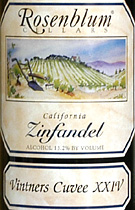|
Tasting the alcohol Wine isn't wine without alcohol in it, as the lackluster quality of the few de-alcoholized wines on the market demonstrates. Without getting into the physical and psychological effects of alcohol today, let's take a look at alcohol's effect on the taste of wine. Curiously enough, as with so many other things vinous, balance proves to be the key: In the opinion of most tasters, too much is just about as serious a flaw as too little; and like Baby Bear's porridge, the wine maker's effort is rewarded when he gets it just right. So what's the taste of alcohol? Speaking of pure ethanol, the active ingredient in wine and other adult beverages, it's all but odorless and flavorless. Its presence in wine appears more as texture than aroma or flavor. Wine with insufficient alcohol - below 11 percent by volume, in most cases - shows this lack in a thin, watery texture that seems to lack sufficient body. In cooler growing regions, achieving sufficient ripeness in the grapes can be a challenge, prompting regulations requiring a minimum alcohol level for quality wines, and inspiring such wine-making tricks as "chaptalization," adding sugar to the just-squeezed grapes to bring up the amount of alcohol in the finished wine. Too much alcohol can be a problem, too, with an excess showing up as a warmth or even heat that seems to throw most table wines out of balance as their alcoholic level approaches and even exceeds 14 percent. Warmer growing regions (and warming climate around the world) can foster overripe grapes with a high sugar content that must either ferment out to startling levels of alcohol or remain as an undesired sweetness in the finished wine, prompting consumer complaints about "blockbuster" Zinfandels, Chardonnays and Shirazes that seem too big and powerful to go well with food. In today's tastings, I report on a couple of pleasant wines that communicate to me a sense of a little more alcohol than they absolutely need. Neither wine is a failure - I would happily accept a second glass of either one - and the Zinfandel's label claims only 13.2 percent alcohol, a bit above the median but certainly not outrageous. But in the never-ending pursuit of wine-tasting pleasure, it's worth paying attention to the alcohol component when it speaks with a louder voice than the rest.  Rosenblum Vintners Cuvee XXIV California Zinfandel ($10.99)
Rosenblum Vintners Cuvee XXIV California Zinfandel ($10.99)
This very dark purple wine, a blend of 2000 and 2001 vintages with a tiny taste of Mourvedre added, is almost black in the glass. Typical Zinfandel blackberry scents add an aromatic "winey" note, with a hint of something minty in the background. Full berry fruit flavors are mouth-filling and ripe, with a strongly warming quality that, with the vinous aromas, convey an impression of more alcohol than the 13.2% that the label claims. (July 22, 2003) FOOD MATCH: Too powerful for my initial choice, a sausage frittata. Better with rare grilled steaks. VALUE: Good value. WHEN TO DRINK: Not really meant for aging, but should hold up well for a few years.
WEB LINK: The winery Website has a substantive tech sheet on Cuvee XXIV:  Viña Borgia 2001 Campo de Borja Grenache ($5.99)
Viña Borgia 2001 Campo de Borja Grenache ($5.99)
Although Viña Borgia is a longtime favorite for a very low-end value price, I find the 2001, with 14% alcohol claimed on the label, pushes the limits for balance. Dark ruby in color, it offers typical Grenache ripe-raspberry aromas with nuances of brown sugar and an edge of charry smoke. Simple black-fruit flavors are warm, full and somewhat pruney, with lemony acidity to give it balance. Rustic and a little rough, it's a decent "spaghetti wine," but it seems a little less refined than previous offerings under this label. U.S. importer: Jorge Ordoñez, represented by Cutting Edge Selections of Fairfax, Ohio, and other regional importers. (July 12, 2003) FOOD MATCH: Red meat; it was OK with a pork chop but perhaps better with a steak. VALUE: Fair at this price, but be wary of paying much more.
WHEN TO DRINK: Best drunk reasonably soon. Administrivia To subscribe or unsubscribe from The 30 Second Wine Advisor, change your E-mail address, or for any other administrative matters, please use the individualized hotlink found at the end of your E-mail edition. If this is not practical, contact me by E-mail at wine@wineloverspage.com, including the exact E-mail address that you used when you subscribed, so I can find your record. We do not use our E-mail list for any other purpose and will never give or sell your name or E-mail address to anyone. I welcome feedback, suggestions, and ideas for future columns. To contact me, please send E-mail to wine@wineloverspage.com All the wine-tasting reports posted here are consumer-oriented. In order to maintain objectivity and avoid conflicts of interest, I purchase all the wines I rate at my own expense in retail stores and accept no samples, gifts or other gratuities from the wine industry.
Friday, July 25, 2003 |




